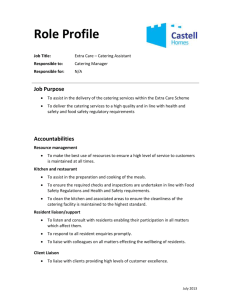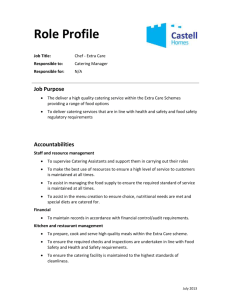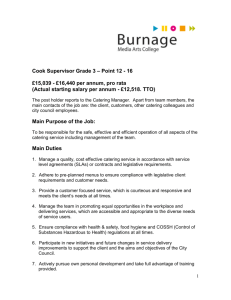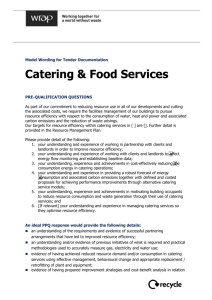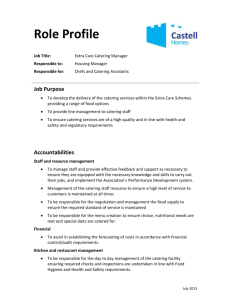Good practice examples - Hospital Caterers Association
advertisement
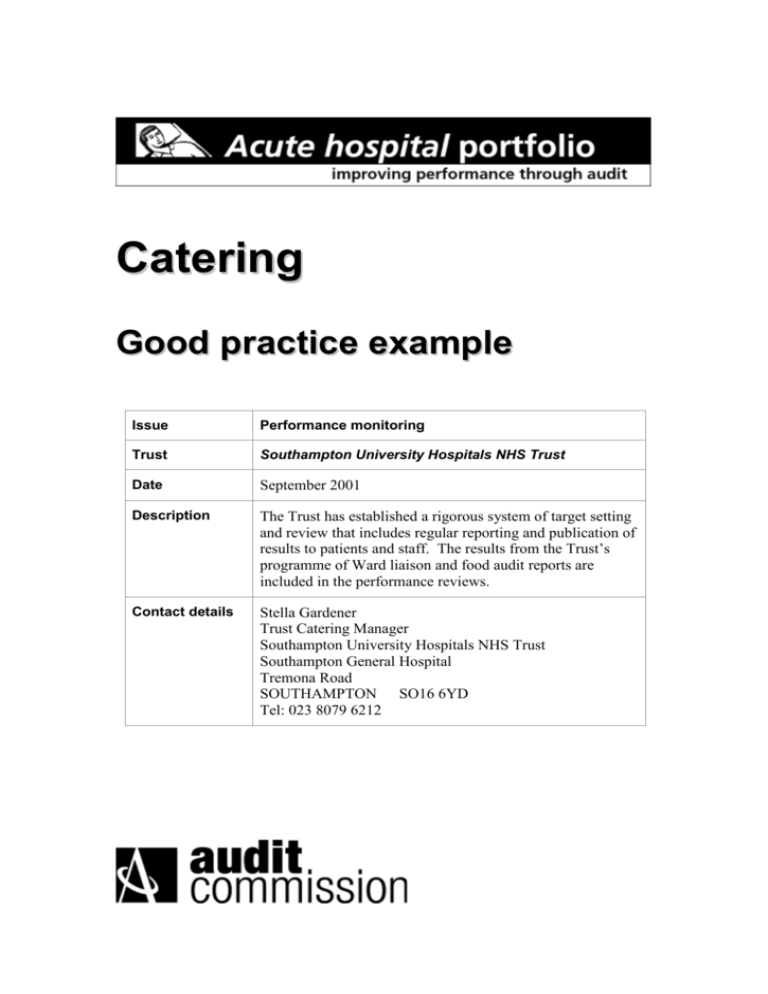
Catering Good practice example Issue Performance monitoring Trust Southampton University Hospitals NHS Trust Date September 2001 Description The Trust has established a rigorous system of target setting and review that includes regular reporting and publication of results to patients and staff. The results from the Trust’s programme of Ward liaison and food audit reports are included in the performance reviews. Contact details Stella Gardener Trust Catering Manager Southampton University Hospitals NHS Trust Southampton General Hospital Tremona Road SOUTHAMPTON SO16 6YD Tel: 023 8079 6212 ACUTE HOSPITAL PORTFOLIO Good practice example 1. Performance monitoring – Southampton University Hospitals NHS Trust What area needs improving? Continuous service improvement doesn’t happen by chance but through good planning and effective control. Trusts should have a clear vision of how the catering service supports the overall achievements of their objectives. The implementation of the NHS Plan recommendations needs to be integral to any department’s programme of work. The setting and monitoring of targets is essential to demonstrate improvements in performance. Southampton University Hospitals NHS Trust has achieved good performance in catering for a number of years and has had a Performance Management Strategy in place since 1996. The challenge for the trust is to ensure that the service continually improves whilst implementing the NHS Plan recommendations. Southampton operates a conventional cook-serve system that is plated centrally and delivered to wards and served by HCA’s with support of domestic staff. They have been awarded Investors in People and Charter Mark. How can this be achieved? Southampton NHS Trust has implemented a rigorous system of target setting and performance review. A yearly business plan for catering is drawn up that outlines market analysis, service strategy and management actions. This sets the objectives and work programme for the year. Much of the 2001/2002 business plan relates to the introduction of the new national dishes by December. The Catering Department has set targets and standards that must be achieved. These focus on patient and user satisfaction, acceptable temperature of food, complaints, achievement against budget and wastage levels. Performance against these targets and the other management actions set out in the business plan are reviewed quarterly by the catering management team. These reviews also incorporate the results of the monthly catering managers’ meetings. At these meetings the actions to the following are discussed: Written compliments & complaints Incident records Informal customer comments Ward liaison and food audit reports (These audits are undertaken on a rolling programme so that each ward is visited every two months. The audit involves a catering manager asking ward staff and patients their views on the catering services and sampling meals for temperature, appearance, smell, taste, texture and portion size). AUDIT COMMISSION 2 ACUTE HOSPITAL PORTFOLIO Performance against targets are then publicised in flyers; ‘Putting patients first’, ‘Caring for our staff and visitors’ and ‘Caring for our staff – theatre vending’. These are displayed on notice boards outside the restaurant and on wards. As a holder of Investors in People, the targets and management actions are cascaded down to objectives for individuals. An annual appraisal takes place for each member of staff where progress is discussed and training needs identified. How much might it cost? Performance monitoring should be an integral part of the operation of a catering department. It is part of the catering management team’s role to undertake the ward liaison and food audit reports. At Southampton they have a Project Manager who overall takes responsibility for quality and wastage issues that are two of the departments key targets. What are the most factors that must be in place for success? Setting priorities for the service – The set targets and objectives must align with these priorities and these need to be communicated to the catering team so that they know where to focus their effort. Making monitoring routine – Monitoring of performance against targets should not be seen as a one-off task but embedded into the operation of the department. By making monitoring routine it encourages staff to think about the next improvement so services don’t stand still but continuously improve. How well did the trust perform on the diagnostic indicators? The results of the diagnostic audit show Southampton NHS Trust performance as: Total net cost per patient day at the median Patient provision costs per patient day at the lower quartile Wastage levels at the lower quartile Patient satisfaction at the upper quartile Monitoring checklist at the upper quartile Nutrition checklist at the upper quartile AUDIT COMMISSION 3

